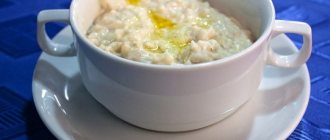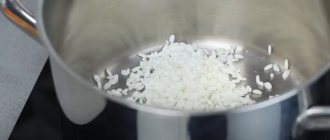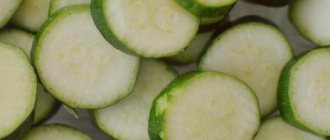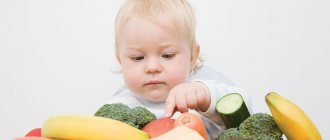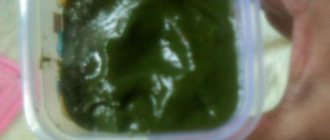Rules for creating a menu at 6 months
At first, the main task of introducing cereals, vegetables or kefir is not so much to compensate for the lack of nutrients, but to train the child’s entire digestive system.
After all, for six months the child’s body received and digested exclusively breast milk/adapted formula. And now the baby will have to try and learn completely new tastes and types of food! Therefore, it is extremely important not to rush and do everything according to the rules. It must be said that fruit juice is not considered complementary foods, but a food additive. According to the rules, it is added to the menu even before complementary feeding begins: at about five months. Start with apple juice, as it is the least allergenic. Then gradually give pear, plum, apricot juices a try. The same additives include cottage cheese, baby cookies, crackers, butter, yolk, and meat. In addition to juice, which is given even before the first complementary feeding, other nutritional supplements are administered in parallel with the main meal.
Age and readiness
For healthy breastfeeding babies, complementary foods are included in the menu from 6 months, for artificial babies - about two weeks earlier. In addition to age limits, there are other signs of readiness for changes in the daily menu:
- the weight of the baby, which was recorded at birth, doubled;
- the child sits well, holds his head confidently;
- may spit out what he does not like or turn his head away from unwanted food;
- knows how to take food from a spoon with his lips, does not choke on food.
What can you feed a 6 month old baby?
Let's say you see that your baby is ready to try unknown food. Decide what complementary foods you will start with. There are three possible options here:
Vegetable
Recommended from 6 months for infants and from 5 months for artificial babies. Start with zucchini, broccoli or cauliflower. Orange vegetables (carrots and pumpkin) are added with caution to avoid an allergic reaction.
Krupyanoy
It is recommended to introduce porridge into the menu for infants from 6.5-7 months, and for bottle-fed babies - from 5.5-6 months. Buckwheat is considered the best porridge for first feeding - it is rich in iron and is easily digestible. Then they offer other gluten-free cereals: rice, oatmeal. Semolina is not given to children under one year of age.
Fermented milk
Basically, kefir and cottage cheese begin to be given from 7.5 months with breastfeeding and from 6.5 months when feeding with adapted mixtures. Buy low-fat kefir, made especially for children, in small packages.
How to diversify the children's menu
At what age can you give your child cheese?
The age of six months marks a significant expansion of the child’s diet. Previously, it contained formula or milk. Now the baby, to some extent, joins the world of adults. Parents must understand that they cannot simply take any vegetable and give it to their baby. For the first complementary foods, the most hypoallergenic products are selected:
- Among vegetables, these are the Big Five, as mothers jokingly call them: zucchini, broccoli, cauliflower, pumpkin, carrots.
Vegetables for first feeding
Important! When introducing a one-time volume of vegetables into a child’s diet of 75 grams. you need to start adding cold-pressed olive oil to the puree at the rate of 1 tsp. for a full portion (150-180 g).
- From porridges (strictly dairy-free) - corn, buckwheat, rice.
- It is not recommended to introduce fruits first. It is believed that the child will get used to the sweet taste and then refuse vegetables that are not so tasty. There are no strict contraindications. If the mother decides to give the baby a fruit, then let it be an apple or a banana.
- By six months, you can introduce egg yolk into your baby’s diet. Giving it more than three times a week is unacceptable. Protein is not given to toddlers; it is a strong allergen.
- If you want to pamper your child, it is permissible to give him a baby cookie to try (you need to take into account the age label and treat it responsibly) or a regular cookie.
If your baby doesn’t want to eat porridge, you can try making it with the mixture, if it was previously introduced into the diet. As a rule, this helps to avoid whims, and the baby will calmly eat his portion.
Note! A breastfed baby does not require supplemental feeding, except in hot weather. With the start of complementary feeding, even if it is one spoonful of vegetables, water must be given.
Baby needs water
A 6-month-old toddler is learning about different drinks:
- You can start giving him juices, but only diluted with water. Take two parts clean water and one part juice: apple, pear. This is not recommended if your child has problems with bloating. Juices should be introduced into the diet at least two weeks before fruit purees.
- From 4 months, babies are allowed to drink weak decoctions of fennel, lemon balm, mint, and even more so by 6 months. You can buy regular herbs in bulk, or mixtures in filter bags. For busy parents, baby food manufacturers have released granulated herbal teas moderately sweetened with dextrose. Such products are produced by Hipp, Bebivita.
The main variety on the children's table is the new products themselves. The baby should eat them in puree to avoid suffocation (the child is not yet able to eat in the same way as an adult, so it is easier to choke).
A new item on the menu for a baby who is just starting to be fed can be a nibbler. This device is similar to a pacifier, only its tongue is larger and has frequent perforations. You can put a piece of a product familiar to your child inside and give it to him. This will provide massage to children's gums and teach them to chew. For the same purpose, you can produce large dryings without a nibbler.
This is what a nibbler looks like
Attention! All products already introduced into the child’s diet can be combined.
Did you start complementary feeding earlier, around 4 months? According to the norms, this is quite acceptable (although it is undesirable; everything is left to the discretion of the parents). Then the little one eats the following foods:
- Poultry - chicken and turkey;
- Dairy products in the form of cottage cheese. Fermented milk mixture is allowed from six months.
- Prunes join the fruit.
There is more room for creativity here:
- Soups that contain all the introduced products become available. For example, chicken broth, it contains broccoli and pumpkin. Only this dish needs to be put through a blender.
- You can add fruit purees to porridge;
- For dinner, you can also combine meat or poultry and vegetables, serving them as a puree. By the way, this is how you can transfer your baby to a common table. Stew made from zucchini, cauliflower, broccoli and turkey can be eaten by both parents and their child.
The baby eats from the common table
- Desserts also become available to such a child. A baked apple (without cinnamon, of course), cottage cheese with banana puree - what's a substitute for sweets?
Important! You can’t add salt, much less pepper, to your baby’s food. Sugar is also extremely undesirable, at least for up to a year.
To summarize, babies who started feeding at different times should eat the following foods:
- Complementary feeding from 4 months: vegetable purees (broccoli, cauliflower, carrots, pumpkin, zucchini, potatoes), fruit purees (apple, pear, prunes, banana); meat purees (chicken, turkey, beef), yolk, cottage cheese without additives, dairy-free porridge (corn, buckwheat, rice), olive oil.
- Complementary feeding from 5 months: vegetable purees (broccoli, cauliflower, carrots, pumpkin, zucchini), fruit purees (apple, banana), meat purees (chicken), yolk, dairy-free porridge (corn, buckwheat, rice), olive oil.
- Complementary feeding from 6 months: vegetable purees (broccoli, cauliflower, zucchini), dairy-free porridge (corn, buckwheat), yolk, olive oil.
The rest (fermented milk products for children, cookies, juices, teas) is left variably at the discretion of the parents. No matter how the baby is fed, at six months at least half of the food he consumes should be milk or an adapted formula.
Sample menu at 6 months
A child's diet at 6 months when choosing a vegetable complementary feeding option may look like this:
- 6-7 a.m.: 180 ml of breast milk/adapted formula;
- 10 am: 150-170 g of vegetable puree with a quarter of mashed boiled yolk and 30 ml of fruit juice as a food additive;
- 2 pm: 140 ml of milk/formula plus, after an hour and a half, 40 g of fruit juice;
- at 6 and 10 pm the baby sucks mother's milk or receives 180-200 ml of formula.
According to medical rules, a six-month-old child should normally eat approximately 1000 ml of food per day. This means that in each of the five daily meals, the volume of products should reach 200 ml. These are average data so that parents understand the approximate amount of food in one serving.
Diet
A six-month-old baby should eat 5 times a day; try to maintain an interval between feedings of around 4 hours and feed him at the same time, observing the regime so that he gets used to the adult diet. Morning and evening feeding - an adapted mixture. Sample menu for a 6-month-old bottle-fed baby:
- 6-00 – 7-00 – adapted mixture 200 g;
- 10-00 – 11-00 – porridge 100 gr., cottage cheese 40 gr.;
- 14-00 – 15-00 – vegetable puree 100–150 gr., meat puree 40 gr.;
- 18-00 – 19-00 – juice 5 tsp, adapted mixture – 200 g;
- 23-00 – 24-00 – adapted mixture 200 gr.
Let's expand on the question: Corn for breastfeeding: porridge, flakes and other products
The mother can change the composition of the menu products at her discretion, depending on the wishes of the baby.
Dosages and volumes
An important rule is that new food is always given before breast milk or formula. If you do the opposite, then a well-fed baby will most likely refuse to eat an unusual dish.
The dosages in the menu of a 6-month-old breastfed or bottle-fed baby have one important distinctive feature:
- the baby, after feeding from a spoon, supplements his food intake with mother's milk in unlimited quantities, that is, he eats as long as he has the desire;
- The artificial baby needs to be fed with the amount of formula prescribed according to the norms.
Komarovsky says about complementary feeding that a second feeding can be replaced, in which kefir and cottage cheese are given instead of milk. They fed us this way before, when dairy kitchens still existed. Today, mothers have a choice: start complementary feeding with kefir or with seasonal white-green vegetables (zucchini, potatoes, broccoli, squash).
The daily dosages look like this:
- On the first day, give 3-4 teaspoons (15-20 ml) of one percent kefir, and then supplement with milk or formula (180 ml). If you decide to start with vegetables, then start with one teaspoon of vegetable puree, doubling the dose daily until it reaches 150-180 g.
- If the child responded normally, then on the second day the dose is doubled - 30-40 ml plus 155 ml of formula/mother's milk.
- By the third day, the baby already eats 60-80 ml of kefir, and then finishes 100 ml of milk.
- By the fourth, it reaches the normal level of 120-160 ml.
- After reaching the main dosage, start adding cottage cheese. First, it will be one teaspoon (10 g). It must be said that many children spit out pure cottage cheese. In this case, it can be mixed with fruit puree.
- Feeding by the sixth day consists of the following products: kefir - 150 ml, cottage cheese - 20 g, mother's milk or formula - 15 ml.
- Complete replacement of one feeding with kefir and cottage cheese (150 ml and 30 g, respectively) occurs by the seventh day.
For a complete replacement, the volume of kefir should reach 150-160 ml, and cottage cheese - up to 30 g. These figures are stored in the menu until the seventh month. As you can see, it takes about a week to gradually introduce a new product to the menu. Although some pediatricians advise stretching the process even further: starting with half a teaspoon of a new food and increasing it to a full portion in two weeks. By the end of the sixth month, they try to introduce cereal porridge with milk into the menu. Suitable cereals would be rice, oatmeal or buckwheat.
Important! Each cereal is introduced as a separate new product. According to the rules, you cannot feed your baby multigrain mixtures. After each new dish, carefully monitor the child’s health and behavior.
The scheme for introducing porridges is the same as in the case of kefir. It is recommended to replace one of the evening feedings with porridge. Start with 3-4 spoons of the product, bringing up to 180-200 ml of the finished milk-cereal mixture.
Recommendations for introducing complementary foods
Typically, complementary foods are considered to be any liquid fruit or vegetable puree, softened yolks, cereals, juices, including products containing a dairy admixture as an additional food. Against the background of prolonged artificial feeding, the child develops a need for food more saturated with nutrients, so gastroenterologists recommend introducing the first complementary foods at 6 months. Just at this age, the baby’s liver, stomach and intestinal tract fully mature, which means they are ready to absorb food other than mother’s milk or infant formula. Modern research shows that you can start feeding with food that adults eat at 4 or 4.5 months. It all depends on whether the baby has enough vitamins and nutrients supplied through artificial nutrition.
Vegetables and fruits contain all the vitamins and microelements necessary for life
The main recommendations of complementary feeding experts include:
- The diet should include vegetables and fruits of various tastes and textures;
- The start date for complementary feeding should not differ from that recommended by WHO experts;
- For the first two weeks, do not introduce large amounts of gluten-containing foods into the diet when feeding your baby;
- Artificial feeding should be continued even during the introduction of new foods into the baby’s diet as a supplement;
- Do not feed your child animal milk as main meals until 12 months;
- Meals should include foods rich in iron.
Important! Feeding your baby should begin no earlier and no later than six months. The slightest delay in introducing complementary foods can lead to frequent allergic reactions in the future. In addition, the absence of animal milk in the diet increases the risk of developing bronchial obstruction and atopic dermatitis in children.
Prepared meals or home-cooked meals
Industrially produced
milk and cereal mixtures On the other hand, in the wake of general distrust of factory-made products, mom felt calmer when she personally prepared porridge for her pet according to the recipe.
If cow's milk proteins are intolerant, special dairy-free porridges are selected for the baby. And if mom cooks herself, then the cereal is boiled in water.
When purchasing porridge from any manufacturer, carefully study the composition: it should not contain sugar, cow's milk, lecithin, or vanillin. Moreover, there is no place in baby food for preservatives, flavorings and flavor enhancers.
As for fruits and vegetables , products for ready-made factory purees are grown in clean fields, and raw materials for baby food undergo careful selection and certification. Is it possible to be sure of the safety of vegetables and fruits purchased at the market or supermarket? Where did they grow, how were they processed, will they harm the child? These questions can only be answered if these are plants from your own garden or vegetable garden. Otherwise, it is better to stick to ready-made, high-quality baby food.
Complementary feeding table for six-month-old children
Diarrhea in infants while breastfeeding
The importance of introducing fruit juices and purees into the baby’s diet has already been mentioned above. If you feed a six-month-old baby store-bought purees containing sugar, this can negatively affect the gastric mucosa. Therefore, it is recommended to prepare fruit and vegetable purees yourself.
Below is a complementary feeding table that will help you understand exactly what foods your baby should eat.
Complementary feeding chart for six-month-old babies
It is important to control portion sizes and not overfeed the child - this can cause bloating, intestinal colic and loss of appetite in the future. The measure must be observed according to the table. During the complementary feeding period, doctors do not recommend giving up feeding with formula milk, since it is a valuable storehouse of nutrients, similar in composition to mother’s milk.
Kitchen helpers
Three household appliances: a steamer , a blender and a multicooker will definitely be needed by the mother of a six-month-old toddler.
The consistency of dishes for a 6-month-old child should be uniform (homogeneous) so that the baby can easily swallow them. And here a blender will become an indispensable assistant for mom. To ensure that vegetables do not lose their beneficial properties and retain their taste, they are cooked according to the recipe in a double boiler or stewed in a small amount of water. And bananas and apples baked in a slow cooker make a wonderful puree. If you decide to cook porridge completely on your own, then you will need a coffee grinder . It is used to grind buckwheat and rice groats and oatmeal.
In addition to kitchen appliances, special feeding accessories will be useful. When using them, the baby can sit at the table with the rest of the family, thus joining the family meal.
Convenient and useful feeding aids:
- special chair with table. The design is conveniently adjustable in height, and safety belts are provided for safety;
- a bib (bib) will help clothes stay clean, after eating there will be no problems with changing clothes, which babies don’t like so much;
- Dishes made of silicone or soft plastic do not injure children's gums, do not break, and are easy to care for.
Many mothers appreciate the convenience of such a device as a kitchen scale. After all, they help to accurately measure the amount of food specified in recipes, and the dishes always turn out perfectly.
Delicious and healthy recipes
When inventing different recipes, remember that the child must “get to know” all the components of the dish in advance. This is necessary to track possible negative reactions to any product.
You can diversify the children's menu in different directions: vegetable dishes, fruit delicacies, soups, dairy and dairy-free porridges, meat purees .
Vegetable recipes
- Wash 100 g of cauliflower and place on the multicooker rack. After steaming for 15 minutes, puree the cabbage in a blender and cool;
- to prepare pumpkin puree, cut the product into cubes and steam for 20 minutes, then grind with a blender and cool. Carrot puree is prepared in the same way;
- Your baby will surely like carrots with milk prepared according to this recipe: grind the boiled vegetable into a puree, add 4 tbsp. l. hot milk, a few drops of olive oil, and simmer the mixture over heat for 1-2 minutes;
- The recipe for mashed potatoes looks like this: peeled potatoes are soaked in water for about 12 hours to remove starch. Then the potatoes are boiled, rubbed through a sieve, diluted with milk to a liquid puree and simmered over the fire for another minute or two;
- If your baby has tried different vegetables, then you can prepare a whole assortment: 100 g of zucchini, half a carrot, potato. Cook the diced ingredients according to the recipe in a double boiler for 20 minutes. Place the prepared vegetables in a blender, add half a glass of hot water and a teaspoon of olive oil. Then everything is crushed and cooled to room temperature.
Porridge recipes
- Corn and rice porridge can be prepared without milk. The rice is pre-ground in a coffee grinder. Add 3 tablespoons of cereal or cereal flour to a glass of boiling water. Rice cooks for 10 minutes, corn grits will take about half an hour until completely softened.
- Milk porridges are made from whole grain gluten-free cereals: rice, oatmeal, buckwheat. They are washed, filled with water two fingers above the level of the cereal - and cooked until tender. Grind the finished porridge through a sieve or beat with a blender. Then bring to the desired consistency by adding hot milk. After this, the recipe recommends boiling the mixture for 2-3 minutes and adding a little oil.
Juices
- Juices are prepared using a juicer or fruits are grated on a fine grater and squeezed through cheesecloth. No additional sugar or water is needed.
- To make the puree, fruits are grated or ground in a blender and simmered with 2-3 tablespoons of water for 1-2 minutes.
Soup recipe
Two original soup recipes will diversify your baby’s menu:
- For fruit and vegetable soup, cut 2 apples and a carrot into large cubes. The slices are poured into a multicooker with 1-1.5 glasses of water and cooked in the “stew” mode for half an hour, and then crushed with a blender until pureed;
- The recipe for delicious pumpkin soup with milk will be as follows: chop 100 g of pumpkin and 1 carrot and boil. Then add a quarter of the boiled chicken yolk to the vegetables and beat everything with a blender. Add 150 ml of milk, butter, add a little salt and bring the mixture to a boil.
Drinks on the menu
At 6 months, the baby already needs water. It is more convenient to buy special water for infants, packaged in large bottles. When preparing baby food, purified water is also used.
Important! You cannot give your baby distilled, mineral or carbonated water. It is not advisable to drink tea before one year of age, as this drink can slow down the absorption of iron. Whole milk from animals is also contraindicated for 6-month-old children.
In addition to water, according to the rules of a healthy diet, your baby can be given juices. Fruits for them are chosen according to the area of residence. At first it could be apples, then apricots, plums or pears. Juices are not diluted with water and no sugar is added. They are offered in small quantities (40-50 g) after the baby drinks the required amount of milk or formula.
Water can be given from a bottle, but it is better to teach a 6-month-old toddler to drink from a cup.
Video about complementary feeding
Issues of complementary feeding are discussed in the studio of the most famous Ukrainian pediatrician. When complementary feeding can be harmful, what to do if the baby refuses “adult” food - look for answers to these and other pressing questions in the “School of Doctor Komarovsky”.
A child’s health, rules and eating habits are formed from a very early age. Therefore, rationally organizing a children's menu is one of the important parental tasks. Share with other parents what discoveries have your baby had in the world of new tastes?




